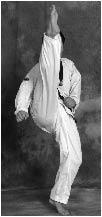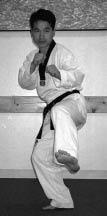Complete Kicking (19 page)
Authors: Turtle Press

common mistakes
The most common mistake is putting too much power in the kick, resulting in a breakdown in posture and inefficient use of your energy as well as potential joint injuries. To correct this, hold a stretching bar and practice slowly without force until you master the path of the kicking motion and can generate force from range of motion rather than muscle power.
• remember
1. Center your body.
2. Generate power from your hips.
3. Keep your base foot firmly Planted.
4. Keep your head as straight as possible.
• avoid
1. Kicking too far past target
2. Breaking the vertical center
Twisting Power
Twisting power comes from coiling and uncoiling the muscles of the torso. Before practicing twisting outward with your kick, you can develop your twisting skills by kicking upward first.
1. Bring your knee forward at a tilted angle. Your arms swing to the left initially and return to this position naturally.
2. Raise your knee to your chest, while pivoting your standing foot.
3. Kick at a target directly on your centerline. Note the difference between this target and the one on page 146, which lies about one foot outside the body.
PUSHING KICK
purpose
Pushing kick is used to stop an incoming opponent or to push away an opponent to create space for a stronger attack. Chamber your knee quickly and push the opponent’s lower abdomen or thigh. You can also raise your nearly straight leg and push straight forward. The goal of this kick is to destroy the opponent’s equilibrium.
key points
Attack the opponent’s center of gravity. Don’t kick too high; kick the middle of the body. Maintain your balance by bringing your arms and torso forward with your kicking momentum.
striking area
Ball, bottom of the foot
targets
1. lower abdomen
2. femoral crease
3. thigh
4. solar plexus
how to
1. From fighting stance, shift your weight to the front leg.
2. Bring your knee forward toward the target.
3. Raise your knee to chest level and push your foot forward. Keep your upper body erect and bring your body weight forward with the momentum of the kick.
* You may push with the ball or bottom of the foot.
variations
Pushing kick is a timing-sensitive technique. Use it to take advantage of an opponent who rushes in recklessly or to push away an indecisve opponent as he hesitates. If you need to react quickly to an opportunity, use a front foot pushing kick; for a powerful push, use the rear foot. The former creates speedy action; the latter an agressive attack.
Hopping front foot pushing kick as a quick counter
Rear foot pushing kick for a powerful attack
applications
Pushing kick is a tactical skill used to better control distance in a fight by unbalancing the opponent’s center of gravity. Push a joint, such as the knee or hip crease. According to the situation, you can push straight forward with a front kick, horizontally with a side kick, or diagonally with a hybrid of the two. The fundamental principles of execution for all of these applications are the same.
SELF-DEFENSE APPLICATION: Use a diagonal pushing kick to the knee to intimidate an opponent.
Other books
Logan's Redemption by Cara Marsi
Dogs by Allan Stratton
A Little White Death by John Lawton
Chasing Glory by Galbraith, DeeAnna
The Wagered Widow by Patricia Veryan
Seduced by Power by Alex Lux
Autobiography of a Fat Bride by Laurie Notaro
One Love by Emery, Lynn
Rodzina by Karen Cushman
The Various Haunts of Men by Susan Hill










